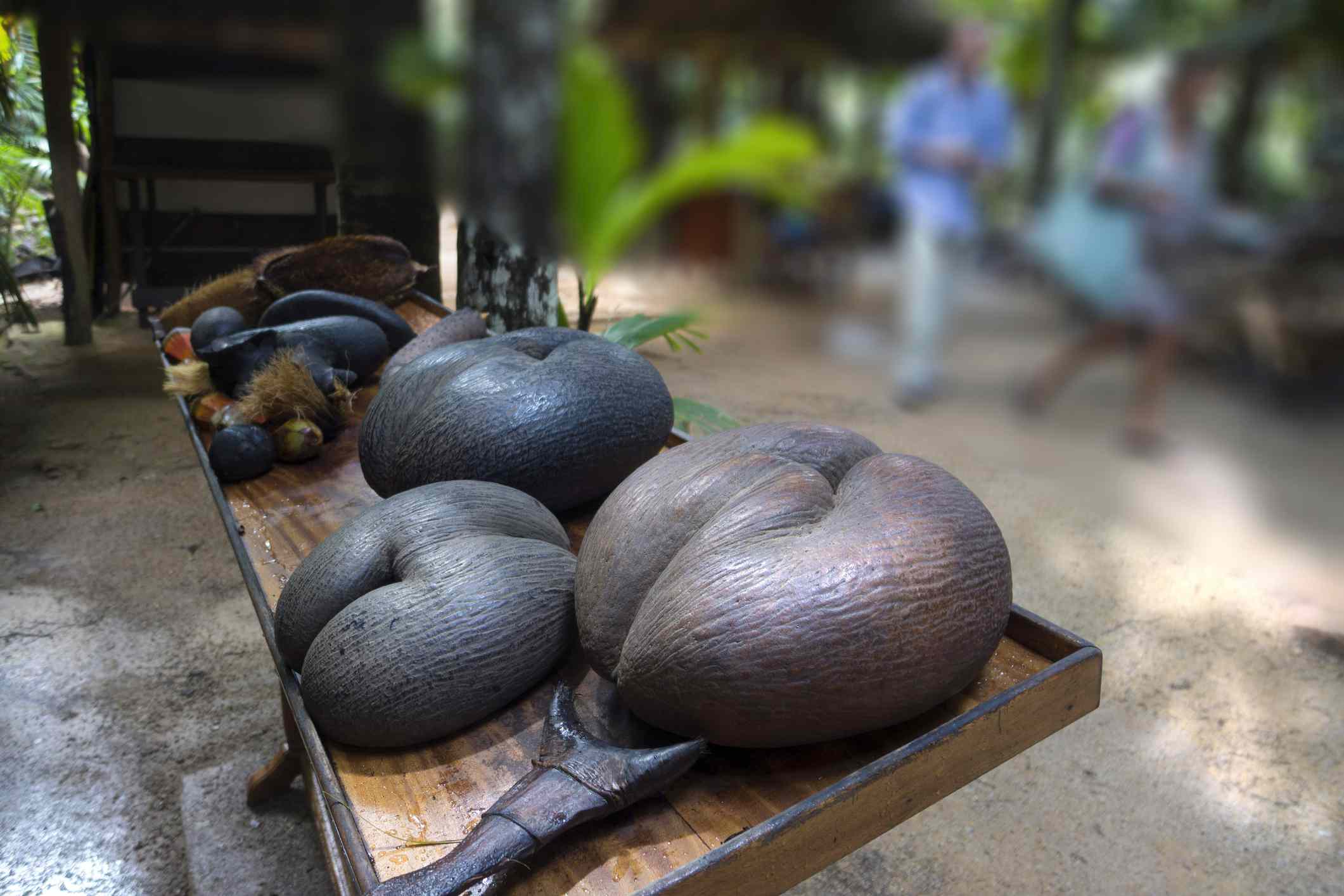Home>Garden Essentials>What Is The Largest Seed


Garden Essentials
What Is The Largest Seed
Modified: March 15, 2024
Discover the biggest garden seed and learn its fascinating features. Explore the world of gardening and find out what makes this seed so special.
(Many of the links in this article redirect to a specific reviewed product. Your purchase of these products through affiliate links helps to generate commission for Storables.com, at no extra cost. Learn more)
Introduction
Welcome to the world of seeds, where nature showcases its incredible diversity. While seeds come in all shapes and sizes, today we are going to explore the realm of the largest seeds found in the plant kingdom. These remarkable specimens not only captivate our imagination but also play an important role in the survival and propagation of various plant species.
Seeds are the reproductive structures of plants and contain the embryonic plant within a protective outer covering. They are the result of a successful fertilization process and serve as a means of dispersal, allowing plants to colonize new areas and ensure their continued existence. Each seed holds incredible potential, harboring the genetic information necessary for a plant to grow and thrive.
Many of us are fascinated by the concept of size, and seeds are no exception. The idea of giant seeds brings to mind images of extraordinary plant species and the mysteries they hold. In this article, we will explore the contenders for the title of largest seed and delve into the unique characteristics that make them stand out in the botanical world.
So, fasten your seatbelts and get ready for a journey into the world of gigantic seeds, where we will encounter astonishing shapes, unmatched sizes, and remarkable adaptations. Let’s begin our exploration of nature’s wonders and uncover the secrets of the largest seeds on Earth.
Key Takeaways:
- The largest seeds, like the Coco de Mer and double coconut, amaze us with their immense size and unique shapes, playing a crucial role in plant survival and ecosystem diversity.
- Large seeds, such as the Seychelles nut and baobab seeds, not only support plant growth but also have cultural significance and contribute to the delicate balance of nature.
Read more: What Is The Largest Mattress
Definition of a Seed
Before we dive deeper into the world of large seeds, let’s start by understanding what exactly a seed is. In botanical terms, a seed is defined as the reproductive structure that houses the embryonic plant and is capable of germinating to produce a new plant under favorable conditions.
A typical seed consists of three primary components: the seed coat, the embryo, and the endosperm. The seed coat acts as a protective layer, shielding the embryo from external threats such as harsh weather conditions, insects, and diseases. It is often thick and durable, ensuring the survival of the embryo during its dormant stage.
The embryo is the young, undeveloped plant contained within the seed. It consists of the future root, stem, and leaves of the plant. As the seed germinates, the embryo will begin to grow and develop into a mature plant, utilizing the energy stored in the endosperm or cotyledons.
The endosperm, also known as the nutritive tissue, is a storage material that provides nourishment to the developing embryo during its early stages. It is typically rich in starches, proteins, and other essential nutrients, which are consumed by the growing plant until it is capable of photosynthesis and independent growth.
Seeds come in a wide range of shapes, sizes, and structures, depending on the plant species. Some seeds are microscopic, barely visible to the naked eye, while others are large and easily recognizable.
Now that we have a clear understanding of what constitutes a seed, let’s embark on a fascinating journey to explore the intriguing world of the largest seeds found in nature.
The Fascination of Large Seeds
Large seeds have always captured the fascination of plant enthusiasts, scientists, and curious minds alike. Their impressive size and distinctive features make them stand out in the plant kingdom, sparking wonder and awe. There are several reasons why large seeds are so intriguing:
- Visual Impact: It’s hard to ignore the presence of a large seed. These seeds often have unique shapes, colors, and textures that make them visually striking. They can be as small as a tennis ball or as large as a human head, commanding attention and leaving a lasting impression.
- Survival Strategies: Large seeds have evolved specific survival strategies to ensure their success. They may have thick seed coats that protect them during long dispersal journeys or provide resistance against harsh environmental conditions. Some large seeds have additional adaptations, such as hooks or spines, that aid in their dispersal by attaching to passing animals or sticking to their fur.
- Ecological Significance: Large seeds play an essential role in plant ecology. They often attract specific animal species that are adapted to disperse or consume them. For example, large fruit with large seeds may be consumed by animals, such as elephants or large birds, and are then dispersed far away from the parent plant. This dispersal mechanism allows plants to colonize new areas and ensures their genetic diversity.
- Symbolism and Cultural Importance: In many cultures, large seeds hold symbolic significance. They are often associated with fertility, abundance, and prosperity. Large seeds, such as acorns or coconuts, have been used for various purposes, including food, building materials, and even religious rituals.
By exploring the world of large seeds, we gain a deeper appreciation for the wonders of nature and the incredible diversity of plant life. These botanical marvels remind us of the intricate and interconnected web of life that exists on our planet.
Now that we understand the fascination behind large seeds, let’s dive into the contenders for the title of the largest seed in the plant kingdom and discover the remarkable characteristics that make them true giants.
The Contenders for the Title of Largest Seed
When it comes to the title of the largest seed, there are a few remarkable contenders in the plant kingdom that deserve recognition. These seeds surpass the average seed size by a significant margin, showcasing nature’s ability to produce extraordinary specimens. Let’s take a closer look at some of these contenders:
- The Coco de Mer: The Coco de Mer, also known as the double coconut, is often hailed as the largest seed in the world. Native to the Seychelles islands in the Indian Ocean, this seed weighs an astonishing 15-30 pounds (6.8-13.6 kilograms) and can reach up to 20 inches (50 centimeters) in diameter. Its impressive size and unique shape, resembling a woman’s hips or a pair of buttocks, have earned it a place in lore and legends throughout history.
- The Double Coconut: As its name suggests, the double coconut is another contender for the title of largest seed. This seed belongs to the Lodoicea maldivica tree, which is native to the Seychelles. The double coconut weighs around 30 pounds (13.6 kilograms) and has a diameter of about 12 inches (30 centimeters). Its hard, woody shell protects the 4-inch (10-centimeter) long seed inside.
- The Seychelles Nut: Also known as Lodoicea callipyge, the Seychelles nut is closely related to the Coco de Mer. It can weigh up to 15 pounds (6.8 kilograms) and has a distinctive shape, resembling a large, elongated pear. Native to the Seychelles, this seed is highly valued for its rarity and unique appearance.
These contenders for the largest seed title not only amaze us with their immense size but also remind us of the incredible diversity and adaptability of plants. Each of these seeds has its own fascinating story, intricately tied to the ecosystems they inhabit and the species that rely on them.
However, it’s important to note that the title of the largest seed can be subjective and may vary depending on different factors, such as weight, diameter, or volume. Nonetheless, these seeds undoubtedly hold a special place in the botanical world and continue to captivate the imagination of those who encounter them.
As we continue our exploration, we will discover more about the Coco de Mer and the double coconut, delving into their unique characteristics and the mysteries surrounding these giants of the plant kingdom.
The Coco de Mer: A True Giant
When it comes to the realm of large seeds, few can rival the awe-inspiring Coco de Mer. Endemic to the Seychelles islands in the Indian Ocean, this majestic palm tree boasts the distinction of producing the largest seed in the plant kingdom.
The Coco de Mer, also known as the double coconut, has captured the fascination of explorers, scientists, and nature enthusiasts for centuries. Its seed is a true giant, weighing an astounding 15-30 pounds (6.8-13.6 kilograms) and measuring up to 20 inches (50 centimeters) in diameter. The seed is enclosed within a hard, woody shell and features a distinct shape that resembles a pair of buttocks or a woman’s hips, adding an air of mystique and allure.
The Coco de Mer tree itself is a marvel of nature. It can grow to heights of up to 100 feet (30 meters), with enormous fronds spanning over 30 feet (9 meters) in length. The tree has separate male and female plants, with the female trees producing large, oblong fruits that contain the iconic Coco de Mer seeds. It takes around six to seven years for the seed to fully mature.
The impressive size and unique shape of the Coco de Mer seed have led to countless legends and tales. In ancient times, these seeds were believed to be a gift from the sea and were highly prized for their supposed mystical and aphrodisiac properties. Due to its rarity and unusual appearance, the Coco de Mer became a sought-after collector’s item, driving its demand and contributing to its conservation efforts.
The Coco de Mer’s natural habitat is the Vallée de Mai Nature Reserve, a UNESCO World Heritage site in the Seychelles. The Reserve is home to a diverse range of plant and animal species, including the endangered Seychelles black parrot, which plays a significant role in the pollination of the Coco de Mer palm.
Conservation efforts have been crucial in preserving the Coco de Mer and its habitat. Strict regulations are in place to prevent illegal harvesting and protect this magnificent and ecologically important palm from extinction. Visitors to the Seychelles can explore the Vallée de Mai Nature Reserve and witness the enchanting beauty of the Coco de Mer tree and its gigantic seed in person.
The Coco de Mer is more than just a giant seed; it is a symbol of nature’s ability to create remarkable and awe-inspiring wonders. Its unique characteristics, intriguing history, and ecological significance make it a true icon of the plant kingdom, reminding us of the extraordinary diversity and beauty that exists in our world.
Now that we have marveled at the magnificent Coco de Mer, it’s time to turn our attention to another contender for the title of the largest seed—the double coconut.
The largest seed in the world is the coco de mer, which comes from a palm tree native to the Seychelles islands. It can weigh up to 30 kg and can take up to 6-7 years to germinate.
Read more: What Is The Largest Grass
The Double Coconut: Another Massive Seed
If you thought the Coco de Mer was impressive, get ready to be amazed by another giant seed from the plant kingdom—the double coconut. Like its cousin, the Coco de Mer, the double coconut belongs to the palm family and is renowned for its enormous size and captivating appearance.
The double coconut, scientifically known as Lodoicea maldivica, is native to the Seychelles islands in the Indian Ocean. This unique palm tree produces a seed that is often considered the second-largest seed in the world. It can weigh an astounding 30 pounds (13.6 kilograms) and measures around 12 inches (30 centimeters) in diameter, making it a true behemoth in the plant kingdom.
The name “double coconut” is derived from the fact that the seed closely resembles two coconuts fused together. It features a hard, woody shell that provides exceptional protection to the seed inside. In fact, the shell is so hard and durable that it requires specialized tools or machinery to crack it open.
The double coconut is not just impressive in terms of its size but also in its ecological significance. The seed serves as a vital food source for a variety of animals in its native habitat. Tortoises, rats, and even some bird species have been observed consuming the nutritious interior of the seed, aiding in the dispersal of the plant and ensuring its survival.
Unlike the Coco de Mer, the double coconut tree does not have separate male and female plants. Instead, it produces both male and female flowers on the same tree. After pollination, the tree develops clusters of fruit, with each fruit containing a single double coconut seed.
Similar to the Coco de Mer, the double coconut has a rich history intertwined with human fascination. In the past, these giant seeds were highly valued and collected as botanical curiosities. Some even made their way into natural history collections and private collections around the world.
While the double coconut is not as well-known or celebrated as its counterpart, the Coco de Mer, it continues to astound and captivate those who encounter it. Its immense size, unusual appearance, and ecological importance make it a remarkable testament to the wonders of the plant world.
Now that we have explored the Coco de Mer and the double coconut, two of the largest seeds in the world, let’s venture further into the realm of large seeds and discover the competitors that come close to claiming the title of giant seeds.
The Seychelles Nut: A Close Competitor
While the Coco de Mer and the double coconut are often in the spotlight as the largest seeds, there is another contender that deserves recognition for its impressive size—the Seychelles nut, scientifically known as Lodoicea callipyge. Native to the Seychelles islands in the Indian Ocean, this seed comes in a close third in the race for the title of largest seed in the plant kingdom.
The Seychelles nut is closely related to the Coco de Mer and shares many similarities. It can weigh up to 15 pounds (6.8 kilograms) and has a distinctive elongated pear shape. The seed is encased within a thick, hard shell, offering protection during its journey from the parent tree to the ground.
Although slightly smaller than its counterparts, the Seychelles nut makes up for it in terms of its rarity and uniqueness. The nut is sought after by collectors and nature enthusiasts for its scarcity and the captivating beauty of its form. Its vibrant green color, combined with its imposing size, makes it a true gem of the plant world.
Like the Coco de Mer and the double coconut, the Seychelles nut tree is dioecious, meaning it has separate male and female trees. The female trees produce the large fruits that house the seeds, while the male trees bear the pollen necessary for pollination. Interestingly, it takes around eight to ten years for the seed to reach maturity.
Similar to its counterparts, the Seychelles nut plays an important ecological role in its native habitat. The large seed serves as a source of nutrition for various animal species, including rodents and birds, which play a vital role in dispersing the seeds across the islands.
Conservation efforts are in place to protect the Seychelles nut and its habitat. The species is listed as vulnerable due to habitat loss and unsustainable harvesting. Efforts to sustainably manage the trees and raise awareness about their importance are crucial for their continued survival.
The Seychelles nut may not be as well-known as the Coco de Mer or the double coconut, but it stands as a testament to the remarkable diversity of the plant kingdom. Its impressive size, coupled with its ecological significance and cultural value, make it a close competitor in the race for the title of largest seed.
As we continue our exploration of large seeds, we will encounter other notable contenders that display astonishing features and further highlight the extraordinary nature of the plant world.
Other Notable Large Seeds in the Plant Kingdom
While the Coco de Mer, double coconut, and Seychelles nut often steal the spotlight as the largest seeds, there are other notable contenders in the plant kingdom that deserve recognition for their impressive size and unique characteristics. Let’s explore some of these remarkable seeds:
- The African Baobab: The baobab tree, known for its iconic swollen trunk, produces large, woody capsules that contain numerous seeds. These seeds are irregularly shaped and can reach sizes of up to 1 inch (2.5 centimeters) in diameter. Baobab seeds are not only considerable in size but also important as a food source for animals and humans in areas where the tree is found.
- The Job’s Tears: Job’s Tears, scientifically known as Coix lacryma-jobi, produce large, bead-like seeds that have been used for centuries for ornamental and medicinal purposes. These tear-shaped seeds come in various colors and can measure up to half an inch (1.3 centimeters) in diameter. Job’s Tears seeds hold cultural significance in many Asian countries and are believed to bring good luck and serve as protective amulets.
- The Horse Chestnut: The horse chestnut tree produces large, round, spiky capsules that contain the chestnut seeds. While not technically a seed in the botanical sense, the chestnut is still worth mentioning due to its considerable size. The seeds are encased in a shiny brown shell and are approximately 1-2 inches (2.5-5 centimeters) in diameter. Horse chestnuts are often coveted for their beauty and are commonly used in crafts and games.
These notable large seeds showcase the diversity and magnificence of the plant kingdom. Each seed has its own unique attributes, adaptive strategies, and cultural significance. They remind us of the intricate connections between plants, animals, and humans, and the roles they play in ecosystems and societies.
It’s important to recognize and appreciate these remarkable seeds, not only for their size but also for the vital contributions they make to the natural world. From providing food and shelter to supporting cultural traditions, large seeds have a significant impact on both the environment and human societies.
As we continue our journey through the world of seeds, it’s clear that nature has countless surprises in store for us. Now, let’s explore the importance of large seeds and how they contribute to the survival and propagation of plant species.
The Importance of Large Seeds
Large seeds play a crucial role in the survival and propagation of plant species. Their unique characteristics and adaptations make them essential for the continued existence of diverse ecosystems. Let’s delve into the importance of large seeds and the ways in which they contribute to the natural world:
- Survival and Regeneration: Large seeds are equipped with a substantial nutrient reserve, providing the essential resources needed for seedlings to establish and grow into mature plants. This ensures their survival in challenging and competitive environments. The abundant nutrients stored within large seeds allow them to withstand adverse conditions, such as drought or nutrient-poor soil, giving them a head start in their journey towards becoming thriving plants.
- Dispersal Mechanisms: Large seeds have evolved various mechanisms for dispersal, allowing plants to colonize new areas and prevent overcrowding. Some large seeds have intricate adaptations, such as hooks, spines, or fleshy fruits, that aid in dispersal by attaching to animals’ fur or enticing them to consume the seed and later excrete it elsewhere. This dispersal mechanism ensures the plant’s genetic diversity, prevents inbreeding, and allows for the colonization of diverse habitats.
- Ecological Interactions: Large seeds often form symbiotic relationships with specific animal species that assist in their dispersal. Animals that consume these seeds not only aid in seed dispersal but also benefit from the nutritional value the seed provides. This mutualistic relationship between plants and animals supports biodiversity and helps maintain healthy ecosystems.
- Food and Resources: Many large seeds serve as a vital food source for a wide range of animals. From herbivores that directly consume the seeds to predators that feed on the animals attracted by the seeds, large seeds form an integral part of the food web. Some seeds are also used by humans as a source of nutrition, for example, various nuts and grains.
- Cultural Significance: Large seeds have cultural and historical significance in many societies worldwide. They have been used for centuries as food, medicine, and materials for crafts. The cultural value attached to these seeds celebrates the interconnection between plants and human cultures, representing traditions, folklore, and rituals passed down through generations.
Large seeds are the driving force behind the growth and persistence of plant communities. Their ability to adapt to different environments, disperse effectively, and provide nourishment ensures the successful establishment of new plants while supporting the complex web of life.
It is crucial that we recognize and appreciate the importance of large seeds in maintaining healthy ecosystems. Conservation efforts aimed at protecting these remarkable seeds and the habitats in which they thrive are essential to safeguarding biodiversity and maintaining the delicate balance of nature.
As we conclude our exploration of large seeds, let us continue to marvel at the wonders of the plant world and embrace our role as stewards of the environment.
Read more: What Is The Largest Washer Capacity
Conclusion
The world of large seeds is a captivating realm filled with fascinating wonders and incredible diversity. From the Coco de Mer and the double coconut to the Seychelles nut and other notable contenders, these seeds amaze us with their immense size, unique shapes, and remarkable adaptations. They showcase the beauty and complexity of the plant kingdom, offering a glimpse into the mysteries of nature.
Through their substantial size, large seeds play a crucial role in the survival and propagation of plant species. They provide an abundant nutrient reserve for seedlings, ensuring their successful establishment and growth. Their dispersal mechanisms, often aided by animals, allow plants to colonize new areas, maintain genetic diversity, and support thriving ecosystems.
Not only do large seeds contribute to the intricate web of life, but they also hold cultural and historical significance in many societies. They have been used for food, medicine, and symbolic purposes, representing the deep connection between plants and human cultures throughout history.
As we explore the importance and marvel at the wonders of large seeds, it is crucial that we recognize their value and work towards their conservation. Preservation of these remarkable seeds and their habitats is essential to maintain biodiversity and ensure a sustainable future.
So, next time you come across a giant seed or find yourself surrounded by the wonders of nature, take a moment to appreciate the intricacy and beauty of the plant world. Let the mystery of large seeds inspire you to become a steward of the environment, nurturing and protecting these remarkable gifts of nature.
In this journey through the world of large seeds, we have witnessed nature’s incredible diversity, adaptive strategies, and the intricate relationships between plants and their surroundings. Let us continue to learn, explore, and embrace the astonishing wonders that lie within the plant kingdom, for there is always more to discover.
Frequently Asked Questions about What Is The Largest Seed
Was this page helpful?
At Storables.com, we guarantee accurate and reliable information. Our content, validated by Expert Board Contributors, is crafted following stringent Editorial Policies. We're committed to providing you with well-researched, expert-backed insights for all your informational needs.














0 thoughts on “What Is The Largest Seed”